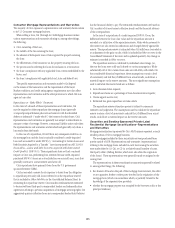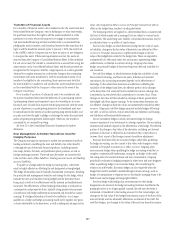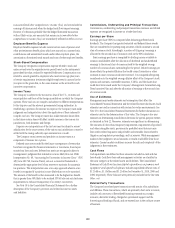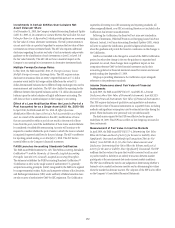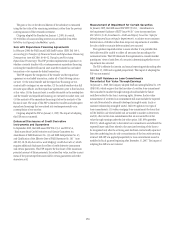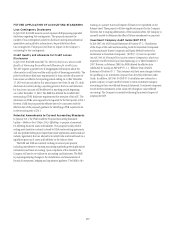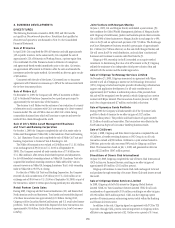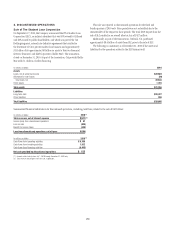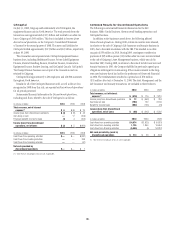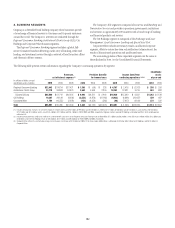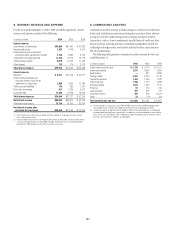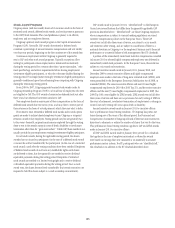Citibank 2010 Annual Report Download - page 177
Download and view the complete annual report
Please find page 177 of the 2010 Citibank annual report below. You can navigate through the pages in the report by either clicking on the pages listed below, or by using the keyword search tool below to find specific information within the annual report.
175
Revisions to the Earnings-per-Share Calculation
In June 2008, the FASB issued FSP EITF 03-6-1, “Determining Whether
Instruments Granted in Share-Based Payment Transactions are Participating
Securities” (now incorporated into ASC 260-10-45-59A, Earnings Per
Share: Participating Securities and the Two-Class Method). Under the FSP,
unvested share-based payment awards that contain nonforfeitable rights to
dividends are considered to be a separate class of common stock and included
in the EPS calculation using the “two-class method.” Citigroup’s restricted
and deferred share awards meet the definition of a participating security. In
accordance with the FSP, restricted and deferred shares are now included as a
separate class of common stock in the basic and diluted EPS calculation.
The following table shows the effect of adopting the FSP on Citigroup’s
basic and diluted EPS:
2010 2009 2008
Basic earnings per share
As reported N/A N/A $(5.59)
Two-class method $0.36 $(0.80) (5.63)
Diluted earnings per share (1)
As reported N/A N/A (5.59)
Two-class method 0.35 (0.80) (5.63)
(1) Diluted EPS is the same as Basic EPS in 2009 and 2008 due to the net loss available to common
shareholders. Using actual diluted shares would result in anti-dilution.
N/A Not applicable
Fair Value Disclosures About Pension Plan Assets
In December 2008, the FASB issued FSP FAS 132(R)-1, Employers’
Disclosures about Pensions and Other Postretirement Benefit Plan Assets
(now incorporated into ASC 715-20-50, Compensation and Benefits—
Disclosure). This FSP requires that more detailed information about plan
assets be disclosed on an annual basis. Citigroup is required to separate plan
assets into the three fair value hierarchy levels and provide a roll-forward of
the changes in fair value of plan assets classified as Level 3.
The disclosures about plan assets required by this FSP are effective for
fiscal years ending after December 15, 2009, but have no effect on the
Consolidated Balance Sheet or Statement of Income.
Additional Disclosures for Derivative Instruments
In March 2008, the FASB issued SFAS No. 161, Disclosures about Derivative
Instruments and Hedging Activities, an Amendment to SFAS 133
(now incorporated into ASC 815-10-50, Derivatives and Hedging—
Disclosure). The Standard requires enhanced disclosures about derivative
instruments and hedged items that are accounted for under ASC 815 related
interpretations. The Standard is effective for all of the Company’s interim
and annual financial statements beginning with the first quarter of 2009.
The Standard expands the disclosure requirements for derivatives and hedged
items and has no impact on how Citigroup accounts for these instruments.
Determining Whether an Instrument (or Embedded
Feature) Is Indexed to an Entity’s Own Stock
Derivative contracts on a company’s own stock may be accounted for as
equity instruments, rather than as assets and liabilities, only if they are both
indexed solely to the company’s stock and settleable in shares.
In June 2008, the FASB ratified the consensus reached by the EITF on
Issue 07-5, “Determining Whether an Instrument (or Embedded Feature)
Is Indexed to an Entity’s Own Stock” (Issue 07-5) (now ASC 815-40-
15-5, Derivatives and Hedging: Evaluating Whether an Instrument
is Considered Indexed to an Entity’s Own Stock). An instrument (or
embedded feature) would not be considered indexed to an entity’s own stock
if its settlement amount is affected by variables other than those used to
determine the fair value of a “plain vanilla” option or forward contract on
equity shares, or if the instrument contains a feature (such as a leverage
factor) that increases exposure to those variables. An equity-linked financial
instrument (or embedded feature) would not be considered indexed to the
entity’s own stock if the strike price is denominated in a currency other than
the issuer’s functional currency.
This issue was effective for Citigroup on January 1, 2009 and did not have
a material impact.
Equity Method Investment Accounting Considerations
In November 2008, the FASB ratified the consensus reached by the EITF on
Issue 08-6, “Equity Method Investment Accounting Considerations” (Issue
08-6) (now ASC 323-10, Investments—Equity Method and Joint Ventures).
An entity shall measure its equity method investment initially at cost. Any
other-than-temporary impairment of an equity method investment should
be recognized in accordance with Opinion 18. An equity method investor
shall not separately test an investee’s underlying assets for impairment.
Share issuance by an investee shall be accounted for as if the equity method
investor had sold a proportionate share of its investment, with a gain or loss
recognized in earnings.
This issue was effective for Citigroup on January 1, 2009, and did not have
a material impact.


